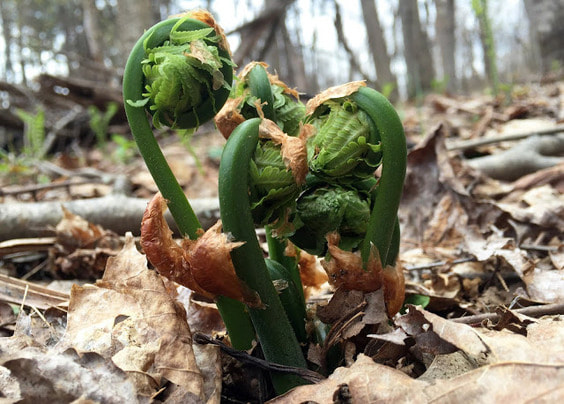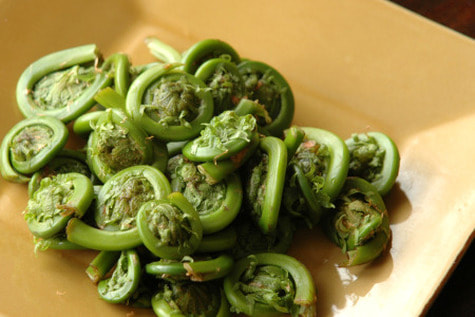Fiddleheads are the young coiled fronds of the ostrich fern. Nearly all ferns have fiddleheads, but the ostrich fern is very distinct. Ostrich fern fiddleheads, are about an inch in diameter, can be identified by the brown papery scale-like covering on the uncoiled fern, and the deep ”U”-shaped groove on the inside of the fern stem. It's at this moment just before they uncurl that it’s time to harvest them.
These springtime delicacies have a taste reminiscent of asparagus. If you cook the fiddlehead like an asparagus you really can’t go wrong. Their flavor is mild, they are pleasantly crunchy. They can be cooked in many different ways, from steamed, to boiled, or dipped in beer batter and fried. I like them sautéed with some garlic, lemon juice in olive oil and butter, lightly sprinkled with salt and pepper. There are many recipes to be found on the internet so when you pick them, they will freeze well.
It is recommended that you cook them for at least 10 and up to 15 minutes before you eat them. Fiddlehead ferns contain a toxin that causes stomach pain in humans when ingested. The toxin is destroyed by the heat generated during the cooking process.
If you have never tried canning them before and want to give it a try, head out to the store and buy a case of canning jars for less than ten dollars. You will also need a good set of tongs to remove the jars from the boiling pot. Right here you can find a link for the how too stuff of the water bath canning method. “For those of you that are into or have wanted to try the canning method, here is one of our favorite recipes. We then add the fiddleheads to a variety of salads throughout the year.
Good Diggin
Bread and Butter Fiddleheads
Ingredients
3 pounds fiddleheads 3 large red onions, thinly sliced
5 cups sugar
7 cups cider vinegar
1 1/2 teaspoons turmeric
1 1/2 teaspoons celery seeds
1 1/2 teaspoons mustard seeds
1 1/2 teaspoons coriander seeds
Makes about 6 pints.
Preparation:
1 Bring a large pot of water to a boil. Add the cleaned and trimmed fiddleheads to the water and cook for 8 minutes. Drain in a colander and lightly pat dry.
2 Mix the brine…..sugar, vinegar, spices and seeds. Over high heat, bring to boil. Reduce heat to low; simmer, for 10 minutes, stirring often.
3 While the brine is cooking, with a slotted spoon place fiddleheads into jars and fill up to 1/2 inch from the top.
4 Now ladle the hot brine over fiddleheads. Process 15 minutes in boiling water process canner. Remove jars from water, and let sit on a towel and to cool completely and insure the tops of jars have popped.
Check for seals (the middle of the caps should have made a popping sound while cooling and will stay depressed. Wait at least a week for the flavors to develop before sampling (they will be even better after a month). The pickles will keep, unopened, at room temperature for at least 1 year (they are still safe to eat after that but the quality will decline). Once opened, store in the refrigerator.


 RSS Feed
RSS Feed